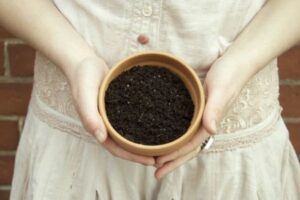The 411 on DIY Organic Potting Soil for the Resilient Container Garden

The topsoil of the Earth’s lithosphere is considered a non-renewable resource because, on average, it takes 100 to 500 years for one inch of topsoil to “grow downward,” with the decomposition of rock and organic matter. However, there are several ways you crafty folks can participate in the game of life by generating your own quasi-dirt potting soil, in most cases in less than 2 years.
If you decide to speed up the process even more by using your purchasing power, do heed this warning: The three leading ingredients in purchased potting soil are: peat moss, (which comes from wetlands in Canada and Michigan) perlite (mined from mountain plateaus, from New Mexico to Oregon), and vermiculite (a mined mineral with many environmental and public health issues). Whether or not these substances garner an ‘organic’ seal of approval (which they technically do), all three of these ingredients contribute to land degradation and pollution; as they are mined, processed, packaged and generally shipped long distances to get to your patio garden, i.e. unsustainable.
But the good news is there are alternative methods to creating at-home potting soils, by combining a little bit of patience with renewable ingredients such as cured compost, sand, leaf mold, and rotted sawdust (from untreated wood).
Cured Compost
Cured compost, which is either heat-treated or pasteurized, can be combined with your best soil or used by itself for germinating seeds, young seedlings, stem cuttings, and your old, rarely reported, houseplants. When making a mix, the rule of thumb is to use more compost and less garden soil or store bought organic potting soil.
After your pasteurized compost is screened it can also be stored – lightly moist – in plastic bags or bins, as it will continue to cure and refine with age, (like all good things in life).
Alternatively, an unpasteurized, biologically active mix of compost is a good thing to use to reduce transplant shock during the transfer of seedlings to larger pots during the hardening phase.
A cautionary note must be added regarding the usage of uncured compost. The bioactive nature of compost (and garden soil) makes it an ideal home for random fungi and bacteria, who when starved of their usual diet of dead things, will turn to consuming the living plant matter that you most likely had plans of eating yourself.
Sand
Perlite ore’s main contributions to store bought potting soil — texture and drainage — can generally be accomplished with sand. To lighten your mix, and help water drain, a little bit of sand goes a long way: add 1/3 – 1/2 cup of sand per quart to your mix. In addition, as a precautionary measure against poor (slow) drainage, a thin layer of sand, rotted leaves, or sawdust can be used at the bottoms of containers.
Leaf Mold and Rotten Sawdust
A great (albeit time consuming) alternative to peat moss is leaf mold (rotted leaves), rotted sawdust or a mixture of the two. As it goes, a 4-by-4-foot mound of chopped leaves will take about two years to decompose into leaf mold; but you resourceful types can explore ways of speeding this up of course.
As with rotted untreated sawdust, which like leaf mold can also compensate for the absence of vermiculite, there are many factors that determine when it can be used and how long it will take to break down to its desired dark, humus like state. For example: the kind of wood you are breaking down, as pine and cedar sawdust are really acidic and therefore require mixing lime or compost in to help with the decomposition. In addition, sawdust by itself will absorb lots of water and use up any available nitrogen, which will stall the breakdown, as well as ruin your potting mix if you add it in too soon. It will take approximately one year to convert raw sawdust into a useful ingredient for your organic potting soil.
pH and Drainage
One easy way to promote the success of your potting mix is to monitor the pH of your soil blend. The pH of your DIY potting mix is determined by what ingredients (and percentages) you use.
Plants like lettuce and many flowers want a soil with a pH of about 7.5 (base or alkaline) and some plants, like strawberries, require an acidic soil, with a pH from 5.5 to 6.
The other aspect to consider in your mix is your water drainage. Cacti and succulents need rapid drainage, so in that case, add more sand. Ferns and woodland flowers require moist conditions, so add more compost, rotted sawdust, or leaf mold for optimal water retention.
To truly take your container gardening off the grid with a self-sufficient DIY potting soil is an investment of time, energy, research and experimentation. If you do not have access to the above ingredients, there is a long list of organic (but not all vegan) ingredients to choose from, including: blood meal (for nitrogen), bone meal (for phosphorus), as well as small amounts of kelp meal and greensand (both for potassium).
Most gardeners up until the 1970s or thereabouts, made their own potting soil by combining their best garden soil with rotted manure, leaf mold, and wood ashes collected around their farm. This lost, resilient quality that Big Ag has made great strides to do away with (for their profit), is making its way back into the public consciousness, thanks in part to you, dear activated reader.
For a list of more ingredients and resources, visit the The National Sustainable Agriculture Information Service page on Potting Mixes for Certified Organic Production.
Follow Baza on Twitter @bazanovic, and remember to garden responsibly.
Image: Genna G.

